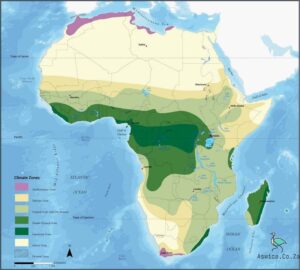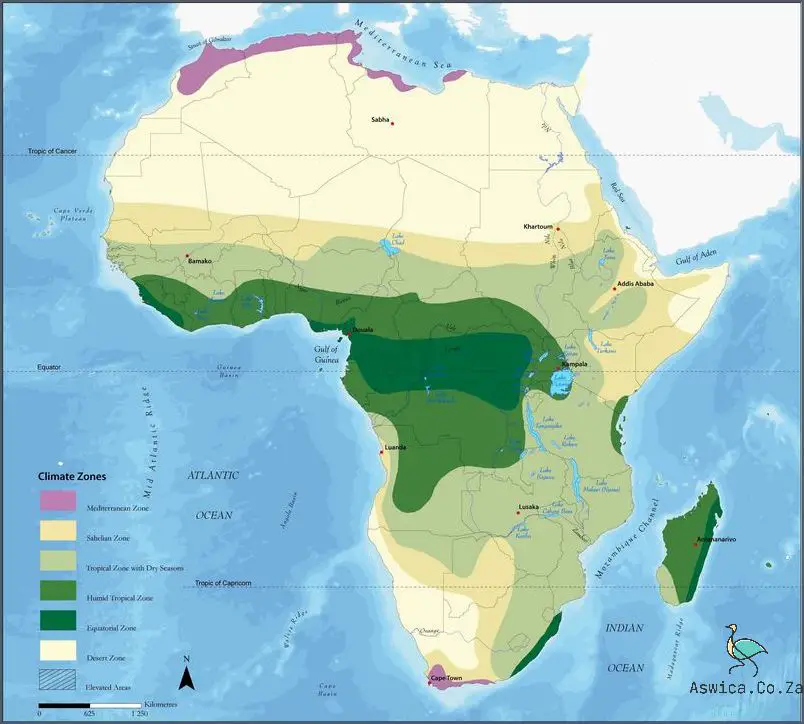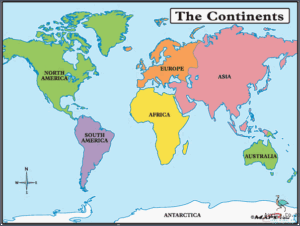
#Climatic Zones South Africa
South Africa is a country located in the southernmost part of Africa. It is a diverse country with a variety of climate zones. The climate in South Africa varies from subtropical to temperate, and there are even some desert regions. The different climate zones in South Africa are determined by a variety of factors, including elevation, latitude, and proximity to the coast.
The subtropical climate zone of South Africa is located in the eastern and northern parts of the country. This region is characterized by hot, humid summers and cool, dry winters. The average temperature in the subtropical climate zone is about 21 degrees Celsius.
The temperate climate zone of South Africa is located in the southwestern part of the country. This region has milder temperatures than the subtropical climate zone, with an average temperature of about 17 degrees Celsius. The temperate climate zone also has more rainfall than the subtropical climate zone.
The desert climate zone of South Africa is located in the northwestern part of the country. This region is characterized by hot, dry summers and cold, wet winters. The average temperature in the desert climate zone is about 15 degrees Celsius.
Contents
Climatic Zones South Africa
South Africa is home to a variety of climatic zones due to its diverse geography. The country generally falls into seven climatic zones, ranging from the Mediterranean climate of the Western Cape to the subtropical climate of KwaZulu-Natal. The Central Plateau has a continental climate with hot summers and cold winters. Further north in Gauteng and Limpopo, the climate is savanna-like with a dry winter season. Moving east into Mpumalanga and Free State, the climate is semi-arid with a hot summer season. The Eastern Cape and Northern Cape are desert-like with a hot, dry climate. The Northern Cape is the hottest region in South Africa, due to its proximity to the Kalahari desert. Each region has its own unique climate and weather patterns, which shape the landscape and its inhabitants.
Overview of South African Climatic Zones
South Africa is a large and diverse country with numerous climatic zones. These climatic zones range from the arid and semi-arid regions of the Northern Cape to the temperate climate of the Western Cape. With such a wide variety of climates, many of the country’s plants and animals have adapted to its specific regions.
The arid and semi-arid regions of the Northern Cape are predominantly desert and grasslands. This region is home to some of the most extreme temperatures in the country, with temperatures reaching up to 50°C in summer. The dry, hot air of the region can make these temperatures feel even hotter.
The winter rainfall area of the Western Cape is the most temperate region of the country. This region receives a majority of its rainfall in winter, resulting in cool temperatures throughout the year. Winters are generally mild and summers are hot, with temperatures rarely reaching above 35°C.
The eastern parts of South Africa have a subtropical climate with hot, humid summers and mild, wet winters. The eastern regions are the wettest in the country and experience the highest level of rainfall of any region.
The temperate grassland region of the Free State and the Eastern Cape is characterised by cool winters and hot summers. This region is known for its temperate climate, with temperatures rarely reaching above 30°C.
The highveld region of the Free State, Gauteng, Limpopo and Mpumalanga is the region with the highest elevation. This region has a continental climate, with hot summers and cold winters. Temperatures can reach up to 35°C in the summer months, but can drop as low as -10°C in winter.

The coastal areas of the Western and Eastern Cape have a Mediterranean climate, with mild, wet winters and hot, dry summers. This region is known for its long stretches of sunny days, with temperatures rarely reaching above 30°C.
Overall, South Africa has a wide variety of climatic zones. Each region has its own unique characteristics, and these regions play a vital role in the country’s biodiversity. With such a range of climates, there is something for everyone in South Africa.
Tropical/Subtropical Climates
South Africa is a diverse country, with a range of climatic zones that span from the tropical regions in the north, to the subtropical areas in the south. The climate in South Africa is largely determined by its geographical location, with its proximity to the equator meaning that the climate is influenced by both tropical and subtropical influences.
In the northern regions, the climate is mostly tropical with hot temperatures, high humidity and intense rainfall. This climate is ideal for rainforest and savannah habitats, which can be found in abundance in Northern South Africa. In the central and southern regions, the climate is more subtropical with cooler temperatures, lower humidity and drier conditions. This climate is better suited to grassland and woodland habitats, which are found in abundance in these areas.
The tropical and subtropical climates of South Africa mean that the country is home to a great variety of flora and fauna. Plants and animals adapted to different climates can be found throughout the country, from the lush rainforests of the north to the dry savannahs of the south. This diversity of habitats provides an ideal home for numerous species of birds, mammals, reptiles, amphibians and invertebrates.
South Africa is also home to a range of climates that can vary between the north and the south. In the north, the climate is mostly warm and humid while in the south, it is cooler and drier. This variety of climates means that South Africa is a great place to explore and enjoy the great outdoors. Whether you want to explore the lush rainforests of the north or the dry savannahs of the south, South Africa is the perfect destination for nature lovers.
Temperate Climates
South Africa is a land of diverse climates, ranging from the warmth of the subtropical east to the cold of the icy south. The country is divided into climatic zones that are each characterized by distinct temperatures, precipitation levels, and other weather conditions. Of these zones, temperate climates are some of the most comfortable to live in and have the highest population density.
Temperate climates are typically found in the southern and western parts of South Africa, where temperatures are milder and precipitation is more evenly distributed throughout the year. These areas typically have warm summers and cool winters, with temperatures rarely reaching extreme highs or lows. Rainfall is higher in the summer and autumn months, and the winter is often dry. This weather pattern is ideal for growing a variety of crops, such as wheat and grapes, and for raising livestock.
Due to its mild temperatures, temperate climates are a popular destination for South African tourists, especially in the winter months when the temperature is more bearable than in other parts of the country. Winters in temperate climates can be quite cold, so it’s important to dress in layers and have warm clothing.
Temperate climates are home to some of the most beautiful landscapes in South Africa. The Western Cape, for example, is known for its rolling hills, vineyards, and picturesque coastline. The Eastern Cape is also a popular destination, with its lush green valleys and rolling hills.
Although temperate climates are generally comfortable to live in, they can be prone to extreme weather events, such as flooding and droughts. In addition, the changing climate is causing unpredictable shifts in weather patterns, making it difficult to predict what kind of weather will occur in the future.
Overall, temperate climates are some of the most desirable places to live in South Africa. They offer comfortable temperatures, beautiful landscapes, and a variety of recreational activities. In addition, the abundance of agricultural produce and livestock, combined with the mild climate, make these areas highly desirable for residents and visitors alike.
Conclusion
In conclusion, South Africa has a diverse range of climatic zones that vary in terms of temperature, rainfall and other climatic factors. The country is divided into four distinct climatic zones, namely the temperate zone, subtropical zone, arid zone, and semi-arid zone. Each of these zones has its own unique characteristics and is home to a variety of flora and fauna. All of these factors combined make South Africa a great destination for biodiversity and a wonderful place to visit for its stunning landscapes and incredible diversity.



